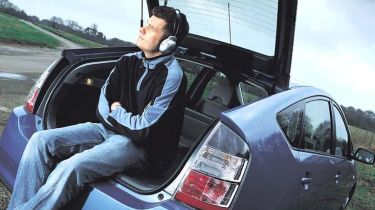Toyota Prius
Ah, the sound of silence! That's what we have got used to with our long-term Prius. The petrol-electric hybrid has become a firm fleet favourite over the past five months, due to its uncanny ability to waft along emitting no noise whatsoever.

Ah, the sound of silence! That's what we have got used to with our long-term Prius. The petrol-electric hybrid has become a firm fleet favourite over the past five months, due to its uncanny ability to waft along emitting no noise whatsoever.
We've commented on this before, but it's worth reiterating how amazed people are when they sample the Prius for the first time. You start up and move off, and passengers are totally thrown by the lack of vibration and noise. To be honest, even with familiarity, it's still unnerving driving in traffic and hearing no sound from your own car.
Provided, that is, you treat the throttle gently. Do so and you will be rewarded at the pumps, because the electric powerplant takes the lion's share of the hard work. Call on maximum thrust, though, or cruise at higher speeds, and the 1.5-litre petrol engine wakes up to supply extra muscle.
In its early days with us, the Prius was employed mainly in town - not least because it's exempt from London congestion charging. So, with the internal-combustion engine required only occasionally, we achieved more than 60mpg.
More recently, though, we've thrown some longer journeys at the Prius, and the fuel economy has come tumbling down - over the past eight tanks we've averaged 45.6mpg. If this is maintained, the model will be no more economical than a regular turbodiesel family hatchback, negating one of the major reasons for buying it. However, we still firmly believe the Toyota is a glimpse of the future - and not only because of the hybrid technology. For starters, there's the way it looks. Unlike the first-generation Prius, it is distinctively designed and has a useful five-door layout.
In other words, it's a practical, everyday family hatch complete with split-fold rear seats - a feature that's come in handy more than once. Passengers have also been pretty comfortable, although taller occupants have commented on the lack of back headroom due to the dipping roofline.
There are a few elements of the driving environment I'm not happy with. Even after all this time, the back-to-front gearlever still confuses: you push it forwards to reverse and vice versa. Still, once you're used to this, it's nice to drive a car in which gearchanges are so simple. The stubby lever has slots only for forwards, backwards and park. I'm also a convert to the power flow chart on the central screen. This shows which energy source is driving the wheels, and other useful data such as whether the battery is being recharged. It's addictive viewing, and makes you try to drive as efficiently as possible.
As far as comfort goes, my six-foot five-inch frame has only a few things to moan about. The seating position is rather odd and there's little lateral support, but it's comfortable on long trips. And even though I push the chair back as far as it will go, rear legroom is adequate. I also like the steering wheel's stereo-control buttons - saves fiddling around on the centre console. One mystery I've yet to get to the bottom of regards the wheels. Their plastic wheeltrims are mounted over alloys rather than steel rims. True, this protects them from kerbing, but we don't get the visual benefits of the alloys. I spoke to Toyota, but no one seemed to know why the covers were needed.
This has preyed on my mind simply because there's nothing else to worry about. The 20,000-mile service is ages away and, in true Toyota fashion, we haven't heard a squeak or had anything go wrong. The Prius has been effortless to live with - surely the biggest vote of confidence for a hybrid.







